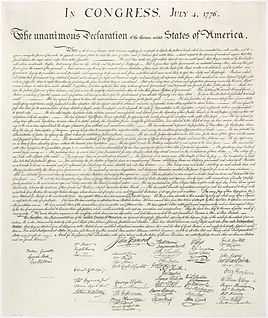William Whipple
| William Whipple | |
|---|---|
 Portrait by Walter Gilman Page | |
| Born |
January 14, 1730 Kittery, Maine |
| Died |
November 28, 1785 (aged 55) New Hampshire |
| Known for | Signer of the United States Declaration of Independence |
| Signature |
|
William Whipple, Jr. (January 25, 1731 NS (January 14, 1730 OS – November 28, 1785) was a signatory of the United States Declaration of Independence as a representative of New Hampshire. Whipple was a member of the Continental congress from 1776 through 1779.[1] Before becoming a politician, Whipple worked as both a ship's captain and a merchant. He became a prominent and wealthy member of society until he became a member of the new Hampshire Provincial congress. Whipple died of heart complications in 1785, aged 55.[2]
Personal life
Whipple was born in Kittery in southern Maine, and educated at a common school studying how to be a merchant, judge, and a soldier until he went off to sea. He became a Ship's Master at the age of 21.[3][4] He married his first cousin Catherine Moffat in 1767.[5] Whipple and his wife moved into the now historic Moffatt-Ladd House on Market Street in Portsmouth in 1769.[6][7]
Masonic Affiliation
Whipple was an active member of the Freemasons. Whipple was a member of the St. John's Masonic Lodge while he was an active mason. He was one of nine signatories of the Declaration of Independence who were masons.[8][9]

Time as a Sailor and Merchant
Whipple earned his fortune participating in the Triangle trade of the West Indies and Africa.[10] Whipple became an established and affluent captain, with cargo such as wood, rum, and slaves.[11] In 1759 he landed in Portsmouth, New Hampshire, and in partnership with his brother established himself as a merchant.
Political career
In 1775, he was elected to represent his town at the Provincial Congress that met in Exeter, New Hampshire.[12] In 1776 New Hampshire dissolved the Royal government and reorganized with a House of Representatives and an Executive Council. Whipple became a Council member, and a member of the Committee of Safety, and was elected to the Continental Congress, serving there through 1779.
Views of Equality
Whipple was known for his beliefs that all men were created equal, and is quoted as writing "A recommendation is gone thither for raising some regiments of Blacks. This, I suppose will lay a foundation for the emancipation of those wretches in that country. I hope it will be the means of dispensing the blessings of Freedom to all the human race in America.".[13] In fact, Whipple freed his closest slave, Prince Whipple, in 1781 because he believed could not fight for freedom while in possession of a slave.
Military career
In 1777, he was made Brigadier General of the New Hampshire Militia, participating in the successful expedition against General Burgoyne at the battles of Stillwater and Saratoga raising and commanding a brigade (9th, 10th, 13th and 16th) of New Hampshire militia during the campaign. In 1778, General Whipple led another New Hampshire militia brigade (4th, 5th, 15th, Peabody's and Langdon's) at the Battle of Rhode Island. His slave, Prince Whipple, followed the General to war and served with him throughout. William Whipple freed his slave Prince, having believed he could not fight for liberty and own a slave.[14]
After the Revolution
After the war he became an Associate Justice of the Superior Court of New Hampshire. He suffered from a heart ailment, and died after fainting from atop his horse while traveling his court circuit. He was buried in the Old North Burial Ground in Portsmouth, New Hampshire. In 1976, in conjunction with the American Bicentennial, his headstone was replaced with a new memorial by a local historical association.

Surrender of General Burgoyne
Painted by John Trumbull in 1821, The Surrender of General Burgoyne is an oil painting depicting many of the major officers in the Saratoga Campaign.[15] Brigadier general Whipple is depicted 5th from the right, standing beside fellow brigadier general, John Glover.[16]
References
- State Builders: An Illustrated Historical and Biographical Record of the State of New Hampshire. State Builders Publishing Manchester, NH 1903
- Lives of the Signers to the Declaration of Independence. By Rev. Charles A. goodrich, published by William Reed & Co. New York 1829
- ↑ http://www.ushistory.org/declaration/signers/whipple.htm
- ↑ http://www.ushistory.org/declaration/signers/whipple.htm
- ↑ http://www.dsdi1776.com/signers-by-state/william-whipple/
- ↑ http://www.whipple.org/william/thiswasaman.html
- ↑ http://www.dsdi1776.com/signers-by-state/william-whipple/
- ↑ "Moffatt-Ladd House & Garden".
- ↑ http://www.dsdi1776.com/signers-by-state/william-whipple/
- ↑ http://salinasmasonictemple.weebly.com/famous-masons.html
- ↑ http://foundingfathersblackhills.com/first-president-first-mason/
- ↑ http://www.dsdi1776.com/signers-by-state/william-whipple/
- ↑ http://www.seacoastnh.com/framers/whipple.html
- ↑ http://www.cr.nps.gov/history/online_books/declaration/bio51.htm
- ↑ http://www.whipple.org/william/thiswasaman.html
- ↑ Quarles, Benjamin (August 1975). "Black America at the Time of the Revolutionary War". Ebony: 44, 45. Retrieved 09-03-2011. Check date values in:
|accessdate=(help) - ↑ http://www.aoc.gov/capitol-hill/historic-rotunda-paintings/surrender-general-burgoyne
- ↑ Surrender of General Burgoyne
External links
- Biography by Rev. Charles A. Goodrich, 1856
- Burial site of William Whipple
- Genealogical Reference
- William Whipple at Find a Grave
- Colonial Hall
|
